-
ARTÍCULO ORIGINAL09/07/2021
Brazilian Nursing Association: fight for space in the new federal capital
Revista Brasileira de Enfermagem. 2021;74(3):e20200701
Resumen
ARTÍCULO ORIGINALBrazilian Nursing Association: fight for space in the new federal capital
Revista Brasileira de Enfermagem. 2021;74(3):e20200701
DOI 10.1590/0034-7167-2020-0701
Visualizações0Ver maisABSTRACT
Objectives:
to analyze the transfer process of the Brazilian Nursing Association to its new headquarters in Brasília/Federal District.
Methods:
qualitative, socio-historical, and documental study. The analysis generated the following characteristics: Associate reorganization: the transfer from the Central ABEn headquarters; and the Strategies used in the struggle for the appropriation of space.
Results:
the Brazilian Nursing Association was engaged in a struggle, which lasted nine years, for the acquisition of land in the new Federal Capital, Brasília, to ensure a prestigious place for the Association, and for nursing as well.
Final Considerations:
together with their sections, undertook efforts and implemented strategies to find a space in the new Federal Capital, allowing visibility and recognition to the nursing profession.
-
ARTÍCULO DE REVISIÓN09/07/2021
Good practices for physical restraint in intensive care units: integrative review
Revista Brasileira de Enfermagem. 2021;74(3):e20201166
Resumen
ARTÍCULO DE REVISIÓNGood practices for physical restraint in intensive care units: integrative review
Revista Brasileira de Enfermagem. 2021;74(3):e20201166
DOI 10.1590/0034-7167-2020-1166
Visualizações0Ver maisABSTRACT
Objectives:
to describe the available evidence on indications, complications, care and alternative strategies in the use of physical restraint in adult patients in Intensive Care Units.
Results:
the final selection was of 19 articles, from which the indications, complications, care and alternative strategies were extracted. The studies were conducted between the years 2003 and 2018, with a predominance of the United States; they were mostly classified (58%) in level 6 evidence, being performed by nurses, with multi-professional participation of psychologists, pharmacists, physicians, and nurses.
Conclusions:
the most common practices regarding physical restriction were described, and the need for the elaboration and implementation of protocols on intervention to support decision making was observed.

-
ARTÍCULO ORIGINAL09/07/2021
Evaluación de diferentes métodos de monitoreo de limpieza de superficie en sala operatoria
Revista Brasileira de Enfermagem. 2021;74(3):e20201263
Resumen
ARTÍCULO ORIGINALEvaluación de diferentes métodos de monitoreo de limpieza de superficie en sala operatoria
Revista Brasileira de Enfermagem. 2021;74(3):e20201263
DOI 10.1590/0034-7167-2020-1263
Visualizações0Ver maisRESUMEN
Objetivos:
evaluar diferentes métodos de monitoreo de la presencia de materia orgánica o biológica entre la limpieza y desinfección de la sala quirúrgica.
Métodos:
estudio transversal utilizando la inspección visual, muestras de adenosina trifosfato y cultura microbiológica como indicadores para evaluación de la limpieza y desinfección.
Resultados:
93,3% de las áreas evaluadas visualmente en este estudio se presentaban visualmente limpias, mismo en la presencia de altos niveles de bioluminiscencia en el resultado de adenosina trifosfato y análisis microbiológicos detectando la presencia de microorganismos relevantes para la formación de biofilms.
Conclusiones:
el proceso de limpieza y desinfección redujo la carga microbiana y materia orgánica de las superficies evaluadas, demostrada por los resultados obtenidos por el adenosina trifosfato y evaluación microbiológica, pero la inspección visual como herramienta única para evaluar la eficacia de la limpieza de las superficies, puede generar una falsa impresión de ambiente limpio.
-
ARTÍCULO ORIGINAL09/07/2021
Self-management support of adolescents with type 1 Diabetes Mellitus in the light of healthcare management
Revista Brasileira de Enfermagem. 2021;74(3):e20201252
Resumen
ARTÍCULO ORIGINALSelf-management support of adolescents with type 1 Diabetes Mellitus in the light of healthcare management
Revista Brasileira de Enfermagem. 2021;74(3):e20201252
DOI 10.1590/0034-7167-2020-1252
Visualizações0Ver maisABSTRACT
Objectives:
to analyze the self-management support needs of adolescents with type 1 diabetes mellitus.
Methods:
this qualitative research was carried out between September and December 2017 with nine adolescents in the pediatric outpatient clinic of a university hospital and in their homes. The material collected through semi-structured interviews was interpreted by thematic inductive analysis in the light of the healthcare management concept.
Results:
adolescents’ self-management support needs include longitudinal monitoring by health teams; family support in their training; support from the social network; and a careful look by government officials in the construction of guidelines for dispensing the essential inputs for treatment. However, these needs are not always met satisfactorily, resulting in gaps in this support.
Final Considerations:
these gaps interfere in resolving health demands. Self-care with fragmented support affects the healthcare management dimensions, making it impossible to meet the uniqueness of adolescents in a comprehensive, expanded and ethical way.
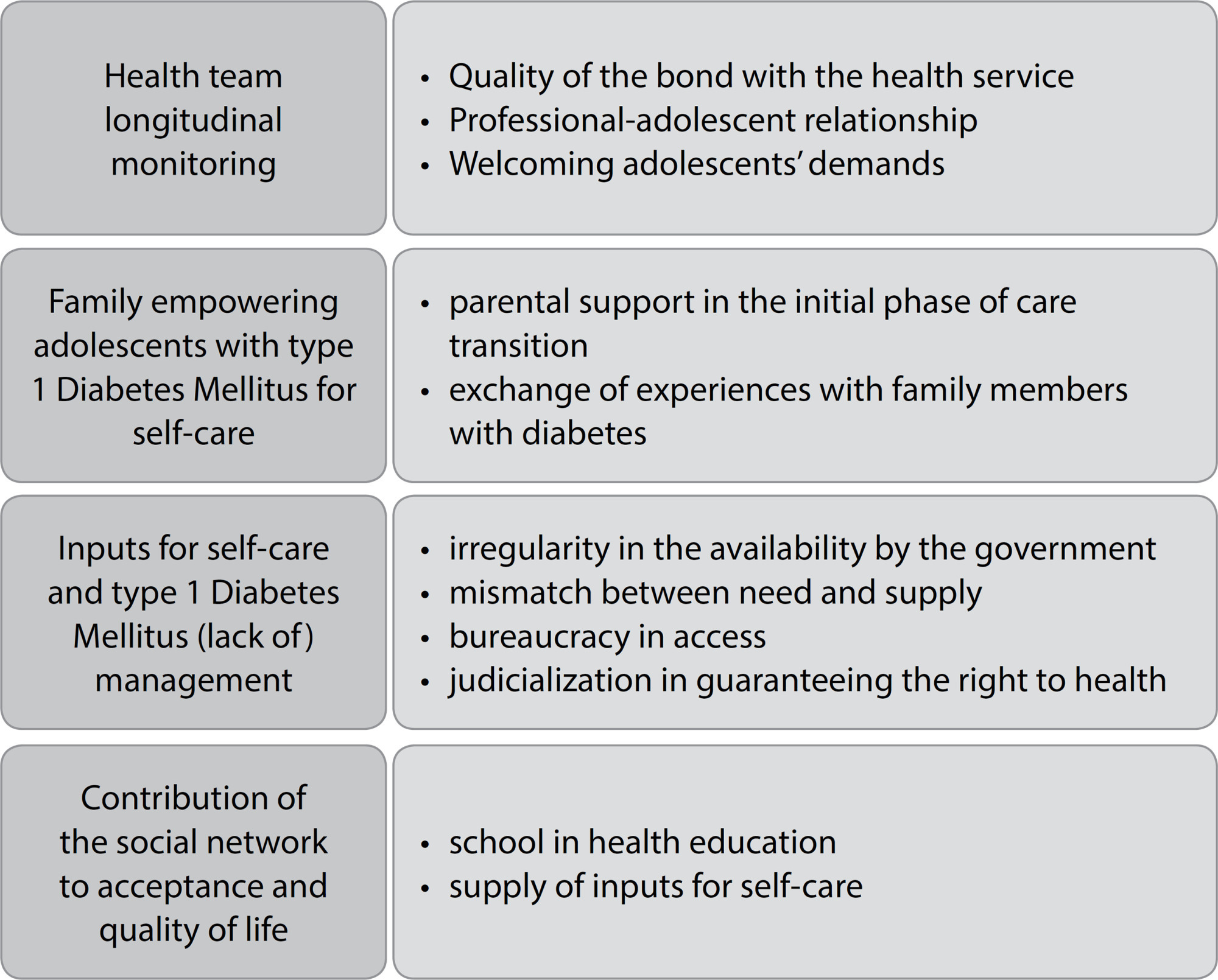
-
ARTÍCULO ORIGINAL09/07/2021
Trend and factors associated with Tuberculosis-Diabetes Mellitus comorbidity in a Northeastern Brazilian municipality
Revista Brasileira de Enfermagem. 2021;74(3):e20201238
Resumen
ARTÍCULO ORIGINALTrend and factors associated with Tuberculosis-Diabetes Mellitus comorbidity in a Northeastern Brazilian municipality
Revista Brasileira de Enfermagem. 2021;74(3):e20201238
DOI 10.1590/0034-7167-2020-1238
Visualizações0Ver maisABSTRACT
Objectives:
to identify the trend and factors associated with Tuberculosis-Diabetes Mellitus comorbidity in Imperatriz, Maranhão.
Methods:
epidemiological temporal-series study, conducted in a Northeastern Brazilian municipality. The population consisted of Tuberculosis cases with Diabetes Mellitus-associated aggravation notified in the Notifiable Diseases Information System (SINAN) between 2009 and 2018. We determined the prevalence and trend of comorbidity using Prais-Winsten regressions and to identify associated factors employed Poisson regression.
Results:
prevalence ranged from 3.23% in 2014 to 19.51% in 2018, with a mean of 11.5% for the period, showing an increasing trend. Age groups 30 to 59 years and ≥ 60 years, education < 8 years, and clinical form of pulmonary Tuberculosis were risk factors for comorbidity.
Conclusions:
The increasing trend of comorbidity and its associated factors alert us to the need to improve customer service at all levels of health care.
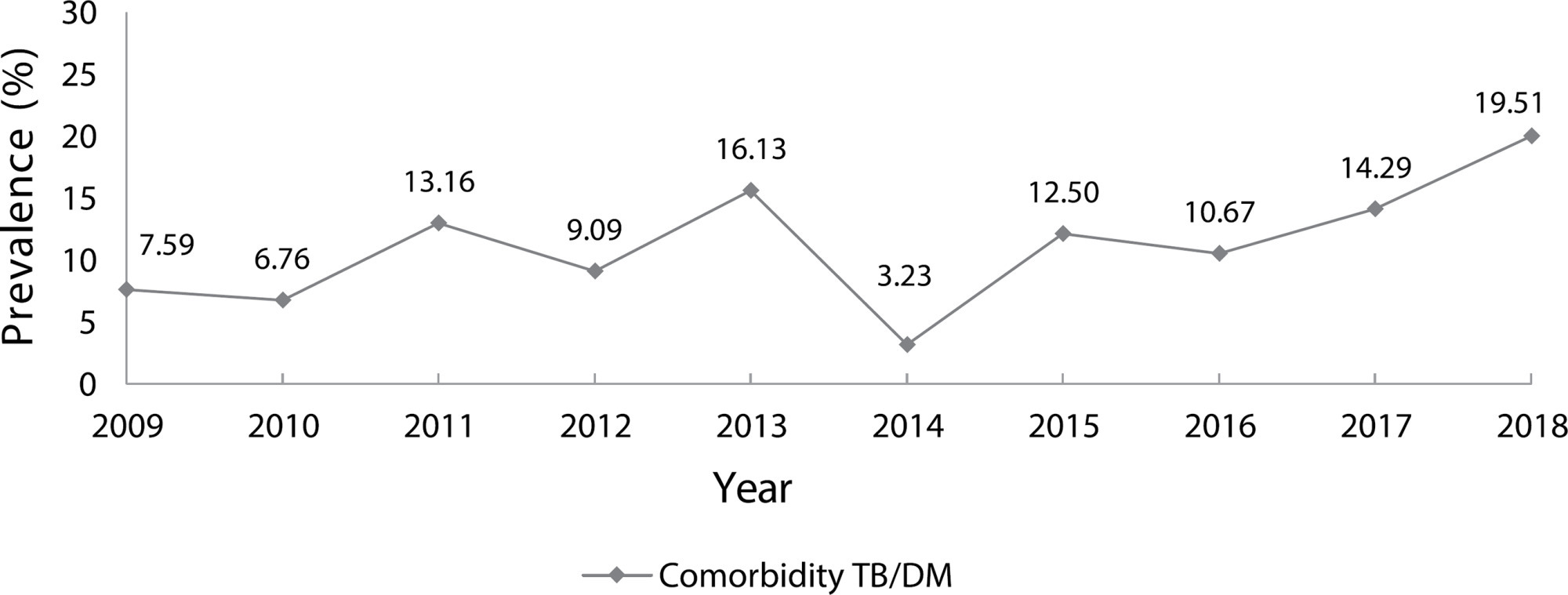
-
09/07/2021
Mortality in community-dwelling elderly: coefficient and associated factors
Revista Brasileira de Enfermagem. 2021;74:e20200612
Resumen
Mortality in community-dwelling elderly: coefficient and associated factors
Revista Brasileira de Enfermagem. 2021;74:e20200612
DOI 10.1590/0034-7167-2020-0612
Visualizações0Ver maisABSTRACT
Objective:
Analyze the coefficient, associated factors, and causes of mortality in community-dwelling elderly.
Method:
Longitudinal and analytical study. Data collection, at baseline, was performed in the elderly’s home. The first wave occurred after 42 months. Complementary data collection identified the cause of death. Variables analyzed: demographic, social, economic, and clinical. Logistic regression was used for data analysis.
Results:
The coefficient of mortality was 7.9%. The variables associated with mortality were longevity, inability to read, absence of religious practice, stroke, consultation, and hospitalization in the last 12 months. The main groups of primary causes of death were ill-defined and unspecified causes of mortality, respiratory system diseases, and neoplasms.
Conclusion:
The coefficient of mortality in community-dwelling elderly was lower than national and international studies investigated.
-
09/07/2021
Algorithm for transitional care for caregivers of dependent older adults: a validation study
Revista Brasileira de Enfermagem. 2021;74:e20200625
Resumen
Algorithm for transitional care for caregivers of dependent older adults: a validation study
Revista Brasileira de Enfermagem. 2021;74:e20200625
DOI 10.1590/0034-7167-2020-0625
Visualizações0Ver maisABSTRACT
Objective:
To construct and validate an algorithm for transitional care for caregivers of dependent older adults.
Method:
This was a methodological study developed in three phases: a literature review, designing an algorithm, and its validation by a peer panel with twenty-seven experts selected according to pre-defined inclusion criteria.
Results:
The algorithm predicted interventions in transitional care (hospital stay, at discharge, and 30 days at home post-discharge) aimed at the exercise of the caregiver role; needs assessment; training in care management of dependent older adults and management of self-care, and ensuring continuity of care (of older adults and caregivers).
Conclusion:
Agreement between expert raters and a reliability test of 0.92 indicate that the algorithm can be used by professionals to decide the transitional care interventions to be administered to the caregivers of dependent older adults. Future studies should be conducted to perform its clinical validation.

-
09/07/2021
Sexuality is associated with the quality of life of the elderly!
Revista Brasileira de Enfermagem. 2021;74:e20201272
Resumen
Sexuality is associated with the quality of life of the elderly!
Revista Brasileira de Enfermagem. 2021;74:e20201272
DOI 10.1590/0034-7167-2020-1272
Visualizações0Ver maisABSTRACT
Objective:
to analyze the association between sexuality and quality of life of Brazilian elderly residents in the community.
Methods:
a cross-sectional study conducted with 477 Brazilian elderly. The data were collected between August and October 2020. We used the EVASI and WHOQOL-OLD (World Health Organization Quality of Life). Data analysis was performed with Mann-Whitney, Spearman and Kruskal-Wallis correlation tests, with Bonferroni post-hoc application when necessary, considering a 95% confidence interval.
Results:
there was a statistical association between all dimensions of sexuality and the general quality of life of the elderly (p<0.05).
Conclusion:
the stimulation of sexuality can be configured as an innovative and holistic strategy focused on the promotion of health and active aging, since this study found the association between sexuality and the general quality of life of elderly people.
-
ARTÍCULO ORIGINAL21/10/2019
Occupational stress and engagement in primary health care workers
Revista Brasileira de Enfermagem. 2019;72(6):1580-1587
Resumen
ARTÍCULO ORIGINALOccupational stress and engagement in primary health care workers
Revista Brasileira de Enfermagem. 2019;72(6):1580-1587
DOI 10.1590/0034-7167-2018-0681
Visualizações0Ver maisABSTRACT
Objective:
To evaluate levels of occupational stress and work engagement among primary health care workers.
Method:
A descriptive, correlational and transversal study was carried out in a small municipality in the countryside of São Paulo, with a non-probabilistic sample of convenience, with 85 workers. Three self-applied instruments were used: one developed by researchers, containing sociodemographic variables; Work Stress Scale (WSS) and Utrech Work Engagement Scale (UWES).
Results:
Prevalence of women (72.6%), 40 years old or more (45.9%), 4 years and 4 months of mean working time in primary care. Thirty-one workers (36.5%) presented significant stress (scores ≥2.5). Work engagement showed a mean of 4.1 (±1.2) to 4.4 (±1.4), classified as high in all dimensions. Occupational stress and work engagement correlated negatively.
Conclusion:
Workers presented high levels of work engagement; more than one-third had significant occupational stress. Workers with high levels of occupational stress tend to have lower work engagement.
-
ARTÍCULO ORIGINAL01/07/2020
Patient safety culture: perception of nursing professionals in high complexity institutions
Revista Brasileira de Enfermagem. 2020;73(5):e20190174
Resumen
ARTÍCULO ORIGINALPatient safety culture: perception of nursing professionals in high complexity institutions
Revista Brasileira de Enfermagem. 2020;73(5):e20190174
DOI 10.1590/0034-7167-2019-0174
Visualizações1Ver maisABSTRACT
Objectives:
to analyze the perception of nursing professionals about patient safety culture in three highly complex hospital institutions.
Methods:
descriptive and quantitative study with professionals working in care. The Hospital Survey on Patient Safety Culture questionnaire was applied, classifying its dimensions according to the percentage of positive responses (strengthened: ≥75.0%; potential for improvement: <75.0% to> 50.0%; weakened: ≤50.0%).
Results:
four hundred sixty-seven professionals (79.6%), mostly women (88.4%), nursing technicians/assistants (57.2%), 20 to 39 years (60.8%), less than five years in the institution (57.8%) and exclusive bond (79.2%) participated in the study. Safety culture was considered fragile, seven dimensions assessed as such, highlighting “Openness to communication” and “Non-punitive responses to errors” with <30.0% positive responses.
Conclusions:
evidence of the need for discussion of the subject and strategies for change that promote quality and safety of care.
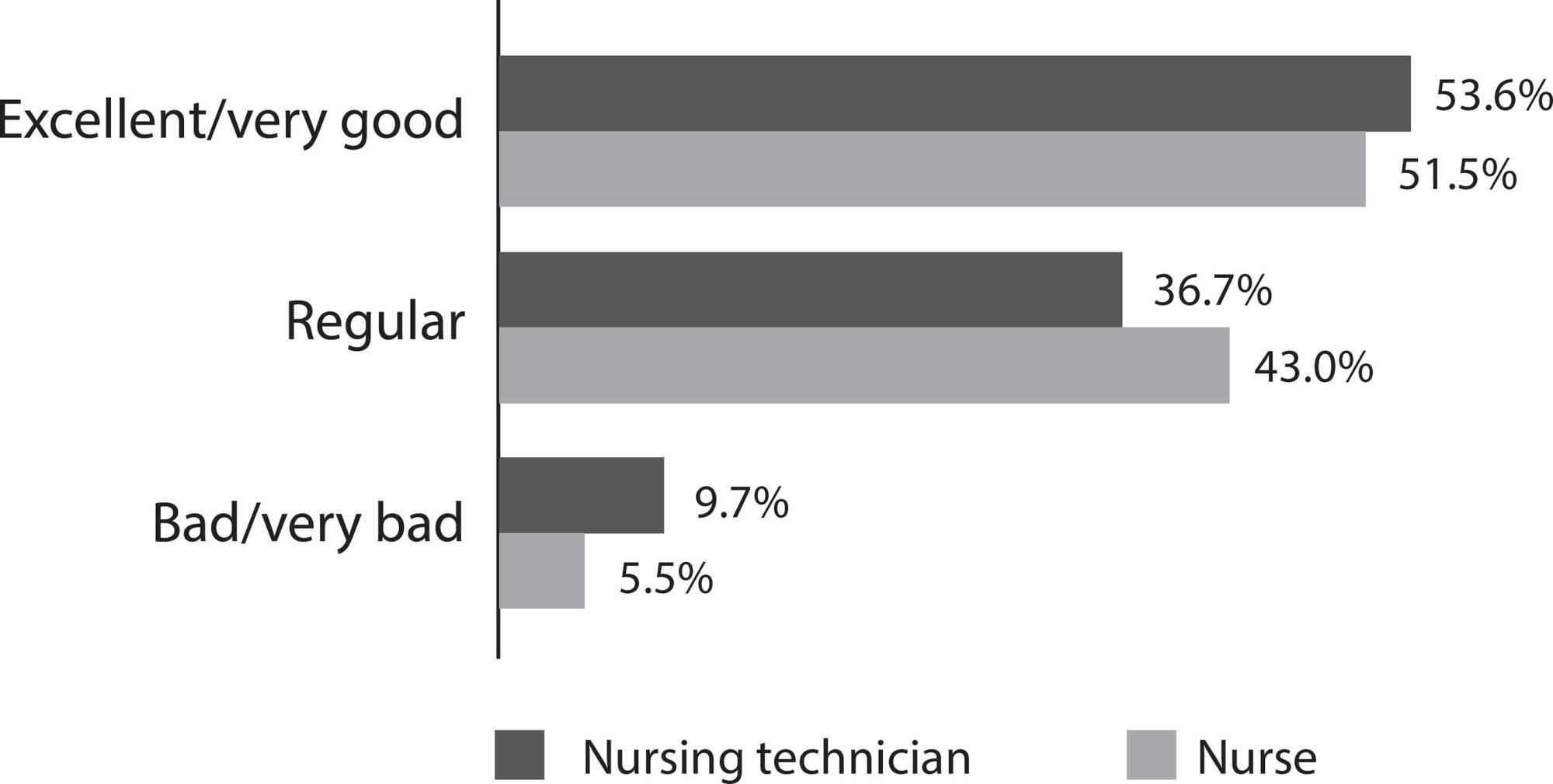
-
ARTÍCULO DE REVISIÓN06/11/2020
Cuidado transicional aos cuidadores de idosos dependentes: revisão integrativa da literatura
Revista Brasileira de Enfermagem. 2020;73:e20200394
Resumen
ARTÍCULO DE REVISIÓNCuidado transicional aos cuidadores de idosos dependentes: revisão integrativa da literatura
Revista Brasileira de Enfermagem. 2020;73:e20200394
DOI 10.1590/0034-7167-2020-0394
Visualizações0Ver maisRESUMO
Objetivo:
Identificar as necessidades dos cuidadores de idosos dependentes para o autocuidado na transição do hospital para casa.
Métodos:
Revisão integrativa que seguiu um protocolo pré-definido, realizada de março a maio de 2019, nas plataformas EBSCO, B-On, Scopus, Web of Science e Joanna Briggs Institute. Foram definidos descritores e critérios de elegibilidade para a amostra bibliográfica, que ficou constituída por dez artigos. Pela atualidade da evidência, limitou-se a pesquisa aos anos de 2015 a 2019.
Resultados:
As necessidades de cuidados transicionais para os cuidadores agrupam-se em cinco categorias: necessidades na transição para o papel de cuidador, necessidades de autocuidado dele próprio, necessidades de saúde, necessidades econômicas e necessidades sociais e comunitárias.
Considerações finais:
O cuidado transicional para os cuidadores deve ter dois focos de atenção, por parte dos enfermeiros: a gestão dos cuidados ao familiar dependente e a gestão das necessidades e dos cuidados ao próprio cuidador.
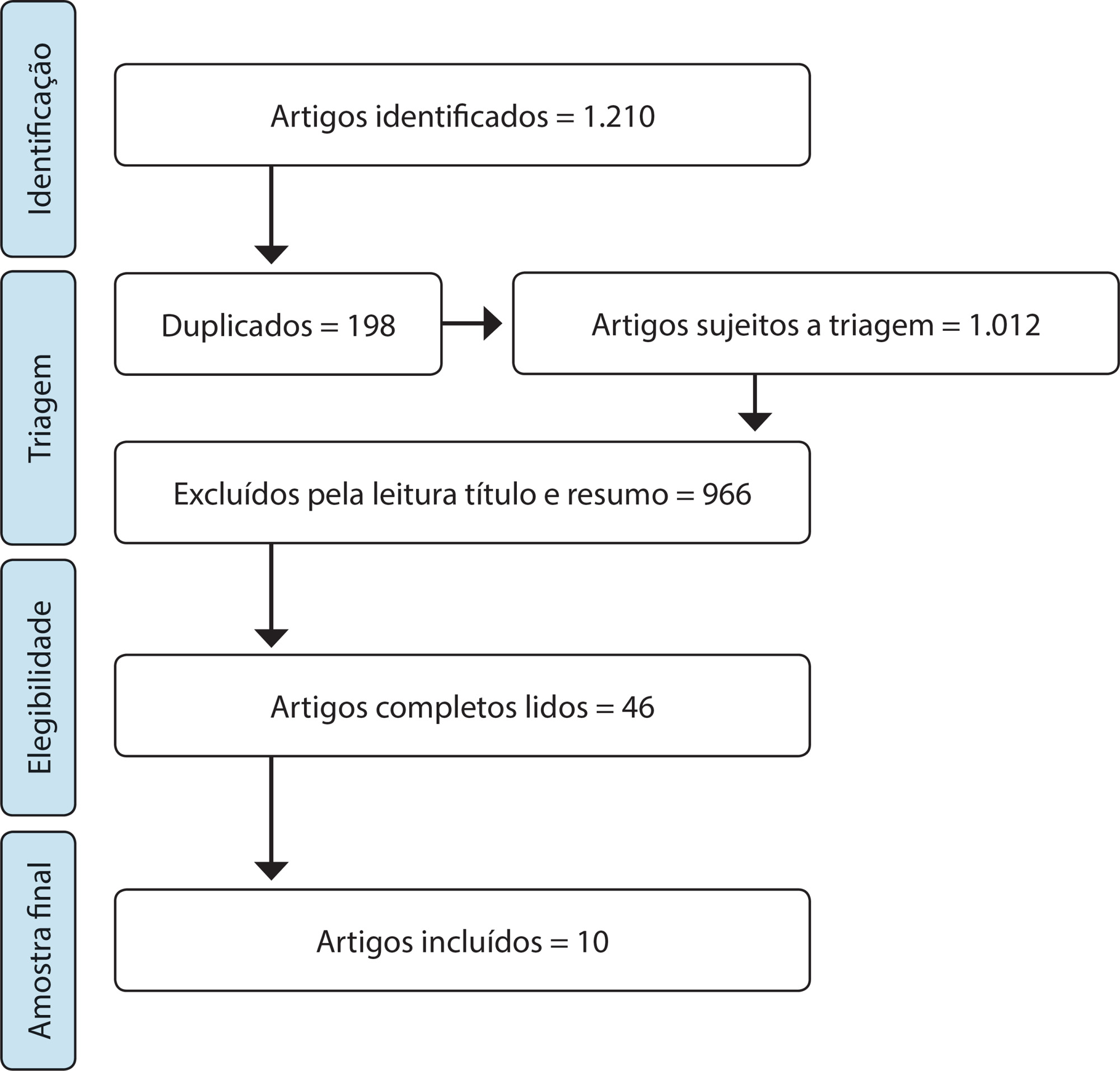
-
ARTÍCULO ORIGINAL24/05/2021
PEDCARE: validação de um aplicativo móvel sobre o autocuidado com o pé diabético
Revista Brasileira de Enfermagem. 2021;74:e20200856
Resumen
ARTÍCULO ORIGINALPEDCARE: validação de um aplicativo móvel sobre o autocuidado com o pé diabético
Revista Brasileira de Enfermagem. 2021;74:e20200856
DOI 10.1590/0034-7167-2020-0856
Visualizações0RESUMO
Objetivo:
descrever o processo de validação de aplicativo multimídia em plataforma móvel para a promoção de cuidado com os pés de pessoas com diabetes.
Método:
estudo de produção tecnológica, do tipo metodológico. O conteúdo e a aparência foram validados por 39 juízes (29 juízes na área de enfermagem e dez com experiência profissional em tecnologia da informação e comunicação e 15 pessoas do público-alvo).
Resultados:
os juízes na área de enfermagem possibilitaram a validação do material com Índice de Validade do Conteúdo total de 0,95, teste binomial não significativo para maioria dos itens e alfa de Cronbach de 0,92, juízes da área de tecnologia da informação e comunicação com Suitability Assessment of Materials de 99,2% e o público-alvo com Índice de Concordância de 98%.
Conclusão:
o aplicativo mostrou-se válido e confiável para uso na prática clínica como tecnologia educacional para promoção de cuidados com os pés de pessoas com diabetes.
Palavras-chave: Aplicativos MóveisDiabetes MellitusEducação em SaúdeEstudos de ValidaçãoPé DiabéticoVer mais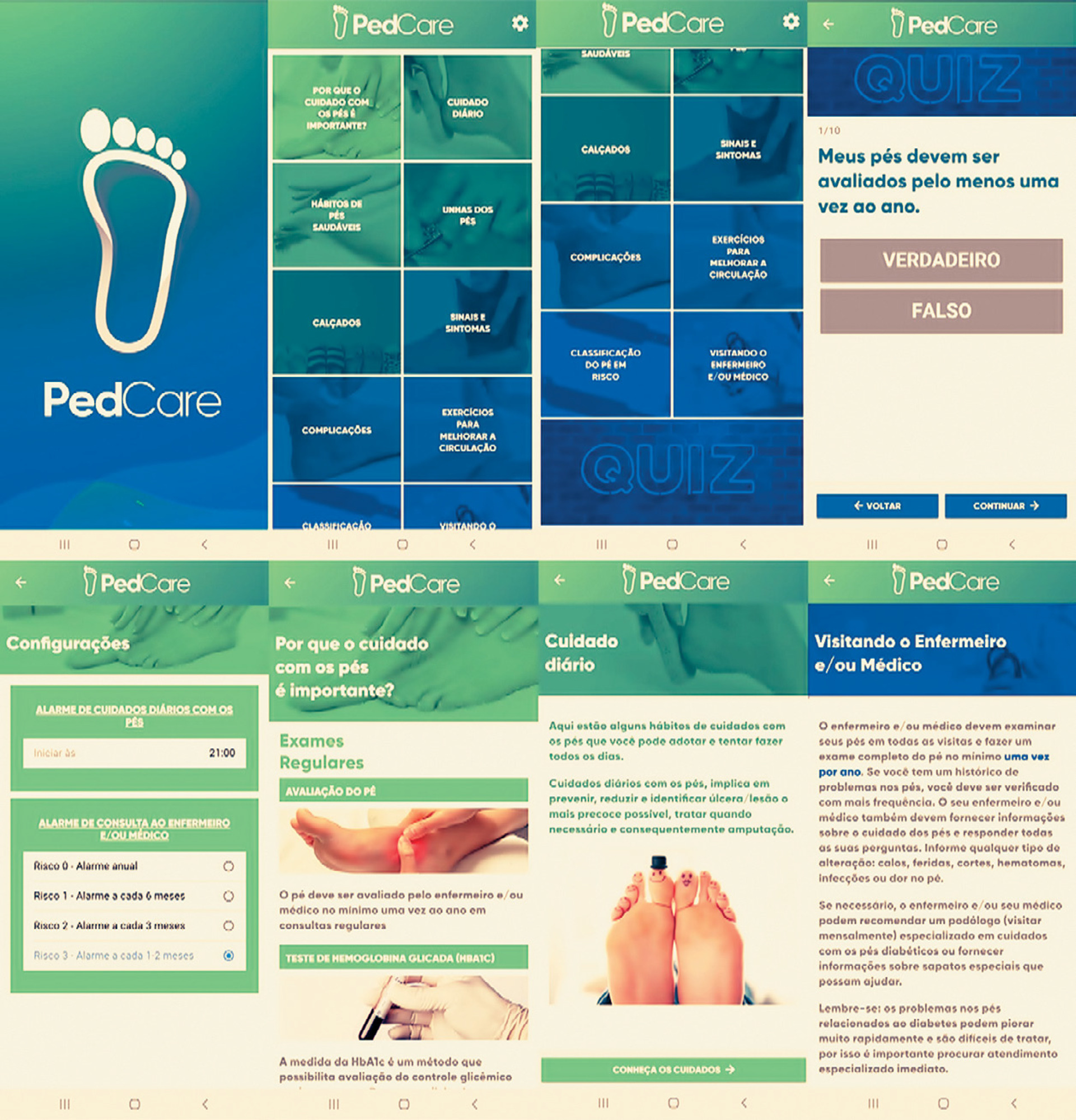
-
INFORME DE EXPERIENCIA09/04/2020
Implantação de algoritmo de inteligência artificial para detecção da sepse
Revista Brasileira de Enfermagem. 2020;73(3):e20180421
Resumen
INFORME DE EXPERIENCIAImplantação de algoritmo de inteligência artificial para detecção da sepse
Revista Brasileira de Enfermagem. 2020;73(3):e20180421
DOI 10.1590/0034-7167-2018-0421
Visualizações0RESUMO
Objetivos:
apresentar a experiência de enfermeiros com inovações tecnológicas computacionais no apoio à identificação precoce da sepse.
Métodos:
relato de experiência de pré e pós-implantação de algoritmos baseados em inteligência artificial para a prática clínica em um hospital filantrópico, no primeiro semestre de 2018.
Resultados:
descrevem a motivação, para criação e uso do algoritmo, o papel do enfermeiro no desenvolvimento e na implantação dessa tecnologia e os seus efeitos no processo de trabalho da enfermagem.
Considerações Finais:
inovações tecnológicas precisam contribuir para a melhoria das práticas profissionais em saúde. Assim, enfermeiros devem reconhecer seu papel em todas as etapas desse processo, de modo a garantir o cuidado seguro, efetivo, centrado no paciente. No caso apresentado, a participação dos enfermeiros no processo de incorporação tecnológica potencializa a rápida tomada de decisão na identificação precoce da sepse.
Palavras-chave: Fidelidade a DiretrizesInformática em EnfermagemInteligência Artificial SepseTomada de DecisõesVer mais -
ARTÍCULO DE REVISIÓN24/03/2021
Development of clinical competence in nursing in simulation: the perspective of Bloom’s taxonomy
Revista Brasileira de Enfermagem. 2021;74(1):e20200135
Resumen
ARTÍCULO DE REVISIÓNDevelopment of clinical competence in nursing in simulation: the perspective of Bloom’s taxonomy
Revista Brasileira de Enfermagem. 2021;74(1):e20200135
DOI 10.1590/0034-7167-2020-0135
Visualizações0Ver maisABSTRACT
Objectives:
to investigate the scientific evidence on the use of Bloom’s taxonomy for developing competence in nursing professionals and students in clinical simulation.
Methods:
integrative review of the National Library of Medicine (NLM), National Institutes of Health (NIH), Cumulative Index to Nursing and Allied Health Literature (CINAHL), Latin American and Caribbean Literature in Health Sciences (LILACS), Web of Science and SCOPUS databases, using the Rayyan application.
Results:
a total of 871 studies were identified; four composed the sample. The development of clinical competence occurred through the coordination of knowledge, skills, and attitudes. To develop the cognitive domain, the objectives of knowledge and comprehension of the Bloom’s taxonomy were mobilized. The psychomotor domain required development of the skills demanded by the proposed clinical care. The affective domain was developed through will and motivation to learn.
Conclusions:
it is possible to develop clinical competence in nursing by adopting Bloom’s taxonomy in each phase of clinical simulation.
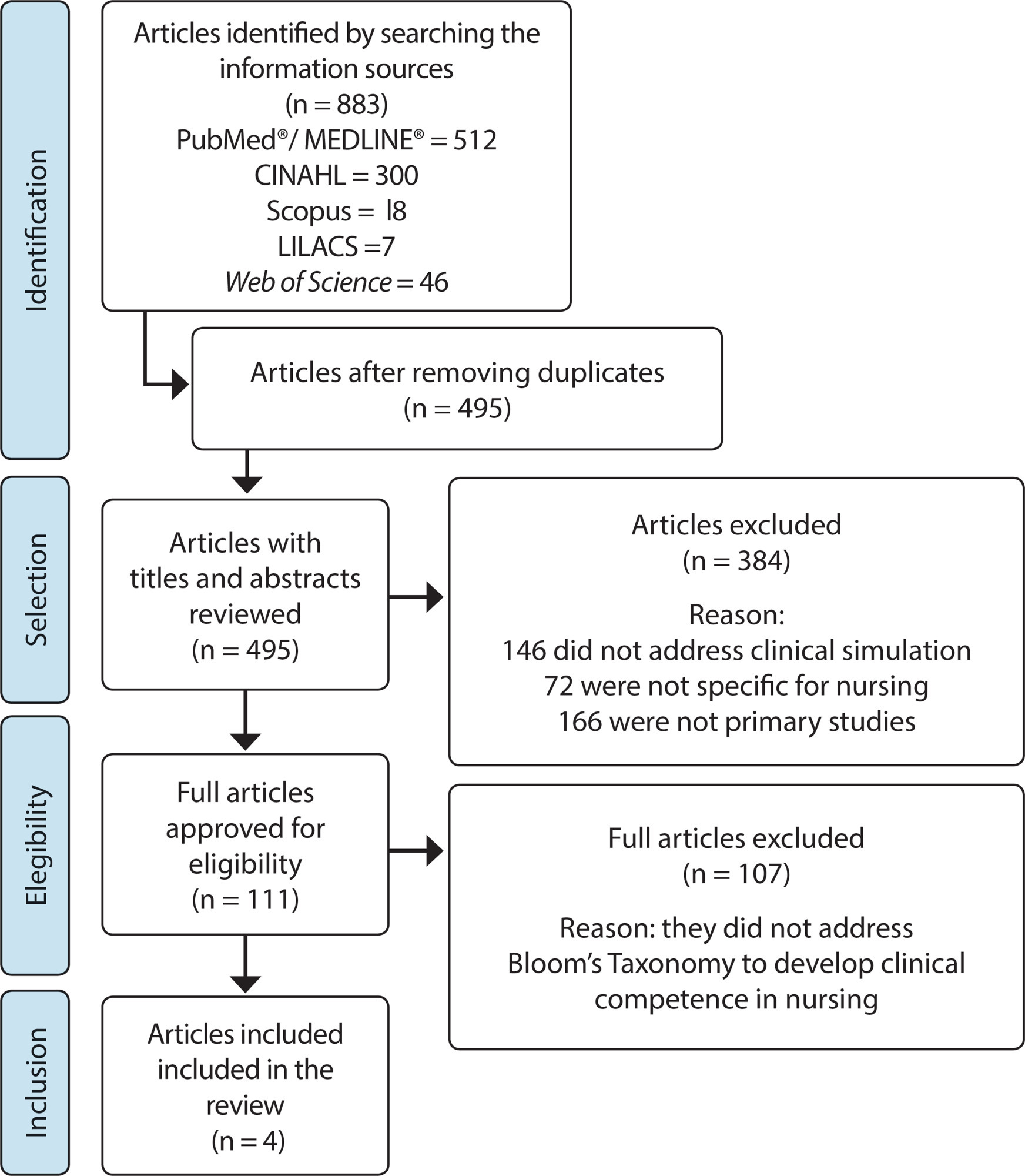
-
27/03/2020
Coronavirus 2020
Revista Brasileira de Enfermagem. 2020;73(2):e2020n2
Resumen
Coronavirus 2020
Revista Brasileira de Enfermagem. 2020;73(2):e2020n2
DOI 10.1590/0034-7167-2020730201
Visualizações0Las enfermedades infecciosas emergentes y reemergentes son desafíos constantes para la salud pública en todo el mundo. Los casos recientes de neumonía de causa desconocida en Wuhan, China, han llevado al descubrimiento de un nuevo tipo de Coronavirus (2019-nCoV), que son virus de RNA envueltos, comúnmente encontrados en humanos, otros mamíferos y aves, capaces de […]Ver mais -
ARTÍCULO ORIGINAL04/12/2020
Lesão por pressão relacionada ao uso de equipamentos de proteção individual na pandemia da COVID-19
Revista Brasileira de Enfermagem. 2020;73:e20200670
Resumen
ARTÍCULO ORIGINALLesão por pressão relacionada ao uso de equipamentos de proteção individual na pandemia da COVID-19
Revista Brasileira de Enfermagem. 2020;73:e20200670
DOI 10.1590/0034-7167-2020-0670
Visualizações0RESUMO
Objetivo:
Descrever prevalência e fatores associados da lesão por pressão relacionada ao uso de equipamentos de proteção individual durante a pandemia da COVID-19.
Métodos:
Estudo transversal realizado por meio de instrumento disponibilizado em redes sociais com 1.106 profissionais de saúde. Os dados foram analisados por meio de estatística descritiva e comparada, considerando valor de p < 0,05.
Resultados:
Houve prevalência de 69,4% para lesão por pressão relacionada ao uso do equipamento de proteção individual, com uma média de 2,4 lesões por profissional. Os fatores significativos foram: menores de 35 anos de idade, trabalhar e fazer uso de equipamentos de proteção individual por mais de seis horas no dia, em unidades hospitalares e sem o uso de insumos para proteção.
Conclusão:
A lesão por pressão relacionada ao uso de dispositivos médicos apresentou alta prevalência nessa população. O reconhecimento da lesão nesses profissionais possibilita avançar em estratégias de prevenção.
Palavras-chave: CoronavírusEquipamento de Proteção IndividualLesão por PressãoPandemiasPessoal de SaúdeVer mais
Búsqueda
Buscar en:
Nuvem de Tags
Adolescente (85) Atenção Primária à Saúde (239) COVID-19 (91) Criança (91) Cuidados de Enfermagem (269) Educação em Enfermagem (151) Educação em Saúde (139) Enfermagem (930) Enfermagem Pediátrica (86) Estudantes de Enfermagem (77) Estudos de Validação (131) Família (87) Idoso (208) Promoção da Saúde (99) Qualidade de Vida (104) Saúde do Trabalhador (86) Saúde Mental (145) Saúde Pública (82) Segurança do Paciente (150) Tecnologia Educacional (100)



